Introduction
Huawei Mate 20 or Huawei Mate 20 Pro? That's one very reasonable dilemma, but you don't have much of a choice, do you? If you are lucky to live in one of the few markets where both phones are available, then you can save some cash by getting the regular Mate 20. But it is one peculiar trade-off with some odd gains and losses. Let's find out if that's a deal worth making.
The Mate 20 is indeed the oddball in this duo. It has a lot in common with the Pro, but it also changes some of the key aspect of the phablet. The screen is bigger with a tiny droplet notch, but an LCD one with lower resolution and without and curves. The body is not water-resistant but has an audio jack and a proper bottom speaker. And the main camera while still triple, is completely different.
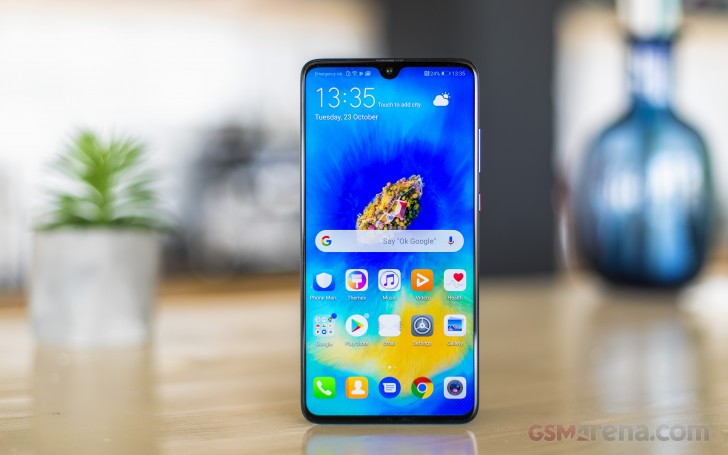
The Mate 20 lacks the new 40W SuperCharge and is stripped of all wireless charging capabilities, but it still can do 22.5W SuperCharge. It also loses the advanced face unlock, and the under-display fingerprint scanner, but gets the fan-favorite blazing-fast reader on the back.
The main camera is the feature to raise the biggest concerns. It's still a triple one, but with different sensors, lenses, and there is no optical stabilization to be found. The Night Mode is present though, so the Mate 20 is keeping its cool under low-light.
Huawei Mate 20 specs
- Body: dual-glass with metal frame; IP53-rated for dust and splash resistance
- Screen: 6.53" RGBW HDR IPS LCD, 1080 x 2244 px resolution (381ppi); waterdrop notch
- Chipset: Kirin 980 chipset, octa-core processor (2xA76 @2.6GHz + 2xA76 @1.92GHz +4xA55 @1.8GHz), Mali-G76 MP10 GPU
- Memory: 4/6GB RAM, 128GB storage (expandable via Nano Memory - hybrid slot)
- OS: Android 9 Pie with EMUI 9;
- Camera: 12MP f/1.8 + 8MP f/2.4 telephoto (54mm) + 16MP f/2.2 ultra-wide (17mm); 4K video capture, 720@960fps slow-mo, Leica branding
- Camera features: 2x optical zoom, EIS, Variable Aperture, Portrait Mode, can shoot long-exposure without a tripod
- Selfie cam: 24MP, f/2.0 Leica lens, Portrait Mode with live bokeh effects
- Battery: 4,000mAh; Super Charge 22.5W
- Security: Fingerprint reader (back), 2D Face Unlock
- Connectivity: Dual SIM, Wi-Fi a/b/g/n/ac, Bluetooth 5 + LE, NFC, USB Type-C
- Misc: IR blaster, 3.5mm audio port
Huawei Mate 20, just like the Pro, has a hybrid SIM slot that supports only the new Nano Memory Cards by Huawei. We are still looking to get one of those, but here is hoping Huawei broadens their availability soon enough.
There is a lot to talk about the Mate 20, so let's start by popping this thing out of the box, shall we?
Unboxing
The Huawei Mate 20 is packed in a rather compact paper box, but don't let the looks fool you - it's full of goodies. The retail bundle contains a fat 22.5W charger and a modified USB-C cable - you need both for Super Charge to work.

Huawei's most recent headphones are inside the box, too.
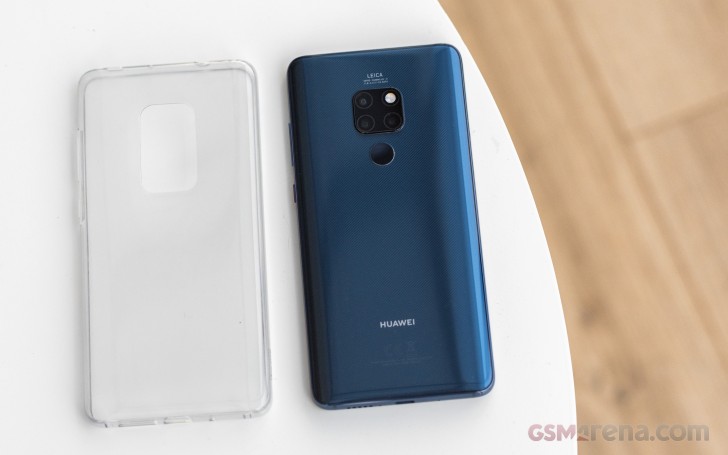
Just like the Mate 20 Pro, some of the Mate 20 retail boxes contain a transparent case - which happened to be present in our reviewer's kit. Not all European markets are getting a case, and whatever the reason might be, we are not happy with this weird segmentation.
Design
The Huawei Mate 20 is arguably the better-designed Mate as it is looking less like a Galaxy and, well, more like a Mate. The flat screen glass and the thicker frame are friendlier for grip and handling - things we hope many still consider essential.
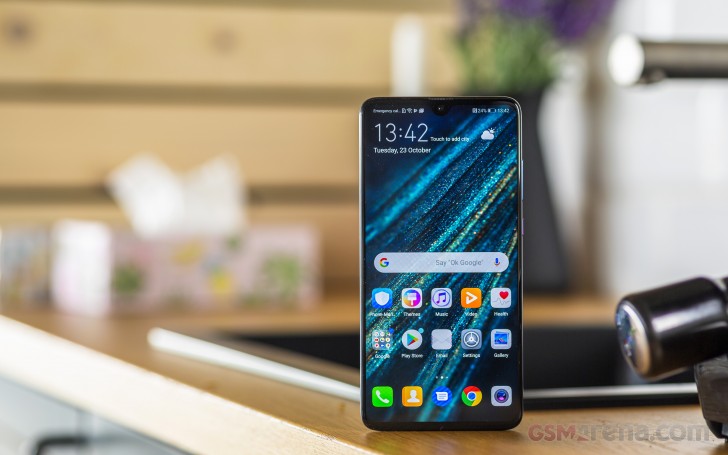
The Mate 20's droplet-like notch is also a pleasant sight. The extra pixels are present only because the advanced 3D face scanning isn't. But some of us still prefer the old-school fingerprint readers instead of bleeding-edge tech that more often gets in the way rather than pushing the experience forward. And we do mean under-display sensors, too.
The Mate 20 isn't breaking from the flagship herd and adds yet another glass-sandwich built to the mix. The dewdrop notch and the square camera on the back add character to the Mate 20 and it's not only unique in its own way but also very different from the old Mate 10.
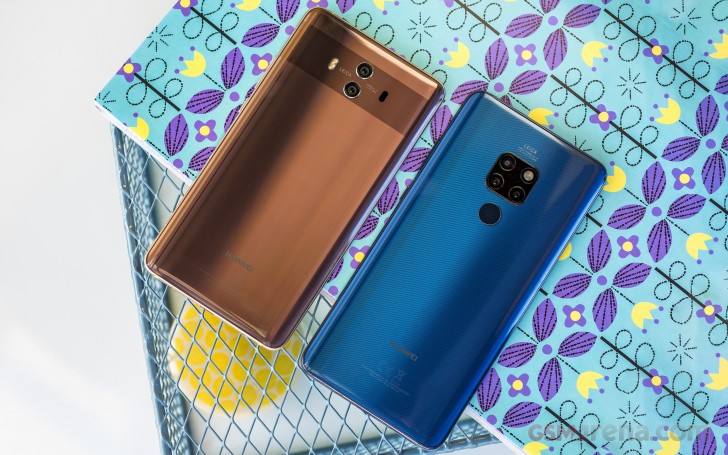 Mate 10 and Mate 20
Mate 10 and Mate 20
Speaking about good looks, the Mate 20 is available in glossy Black and gradient Twilight colors. It also comes in the new signature Midnight Blue option, which has a grippy vinyl-like texture on the rear curved glass. Hyperoptical pattern, they call it.
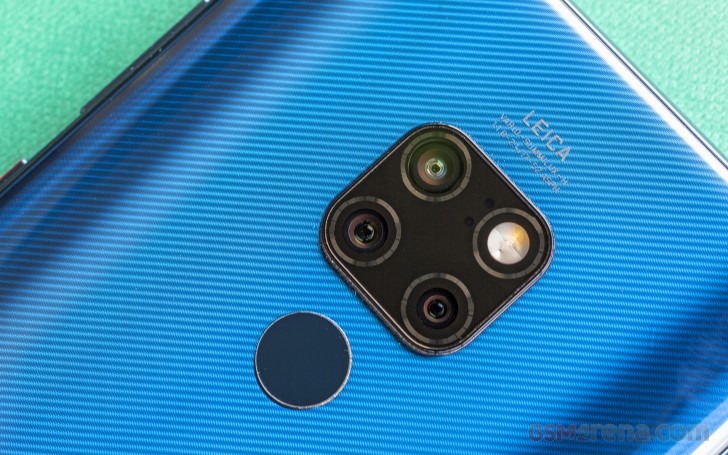
The Mate 10 had its fingerprint reader at the front, right below the screen, but the Mate 20's edge-to-edge screen made that impossible. So, Huawei moved the scanner on the back, and it's still as useful and fast.
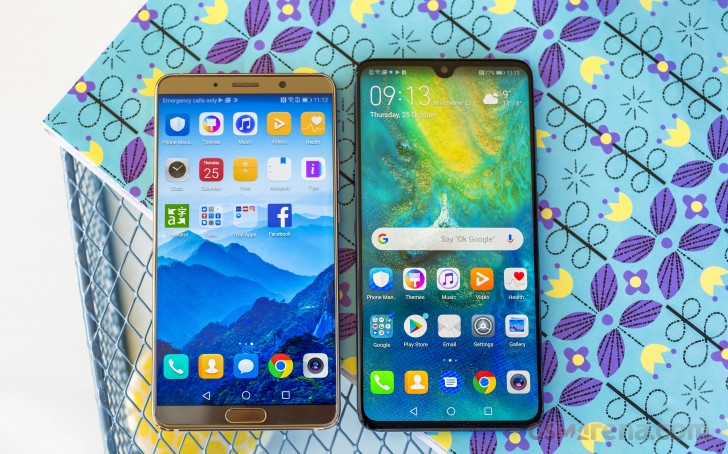 Mate 10 and Mate 20
Mate 10 and Mate 20
The Mate 20 has a slightly larger screen than the Mate 20 Pro, but it's not an OLED one and has a lower 1080p resolution. Huawei is still using a premium panel, though, and a very bright one at that with a special RGBW matrix and HDR10 support.
The small cutout isn't as an eyesore, and inside it packs the selfie camera and a bunch of sensors. The earpiece is outside the screen, etched in the frame, and it doubles as a second speaker.
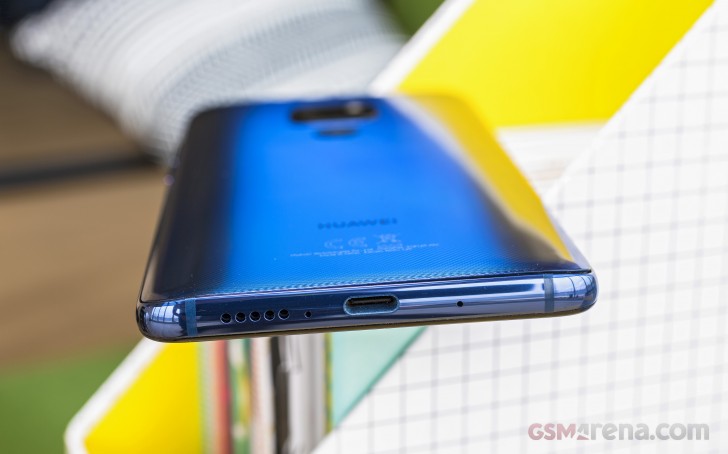
The primary speaker is once again at the bottom, but it's not within the USB port as it is on the Mate 20 Pro! What's even better is the inclusion of a 3.5mm audio port at the top of the phone - again unlike the Mate 20 Pro.
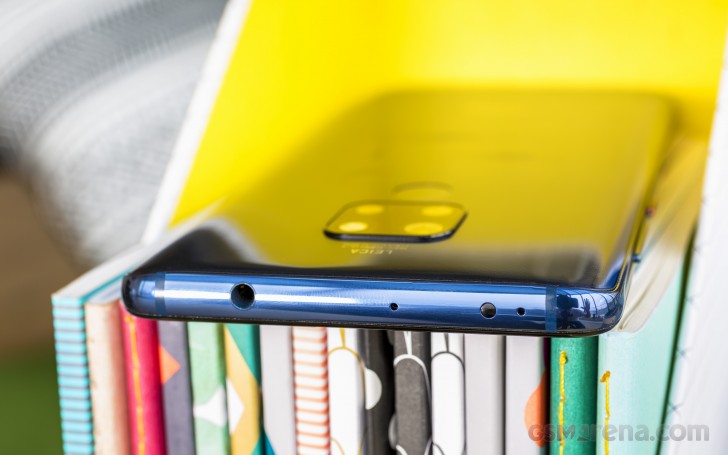
So, the Mate 20 has an audio port (and FM radio!), a smaller notch, conventional speakers, and it even feels more secure in hand than the Mate 20 Pro. But these niceties come at the price of ingress protection. The Mate 20 is only IP53-rated for (some) dust and splash resistance, while the Mate 20 Pro has an IP68-certified dust and water-tight shell.
Then there is the tri-camera, which on the Mate 20 is less impressive compared to the Pro model. It has a 12MP main sensor behind f/1.8 lens, an 8MP cam with f/2.2 telephoto lens, and a 16MP snapper with f/2.2 17mm ultra-wide-angle lens. The monochrome shooter is gone for good, but we can't imagine someone missing it badly.

The 80mm zoom lens and optical stabilization for the telephoto camera are reserved for the Mate 20 Pro. The Mate 20 only gets 2x optical zoom, and there is no OIS at all.
The camera is still a major step forward over the Mate 10, no two words about it, though slightly disappointing when you've seen the alternative.
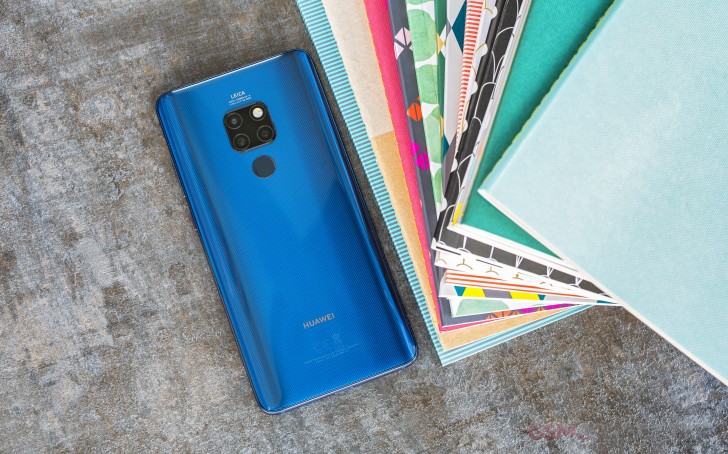
The good news is Huawei's AIS stabilization is here to stay, and it should be at least as good as on the P20. The Night Mode from the P20 phones is another goody available on both Mates, so the Mate 20 isn't losing those cool long-exposure handheld photos.




Huawei Mate 20
For better or worse, the Mate 20, just like the Mate 20 Pro, is pioneering the hybrid SIM slot with a new type of Nano-Memory Cards. These cards are invented by Huawei and have the shape of a nanoSIM, while packing up to 256 gigabytes of storage. Unfortunately, they are so new that you can't really buy them anywhere. We can list a lot of reasons why the NM cards just don't make sense, but we think most, if not all of you are already on the same page.
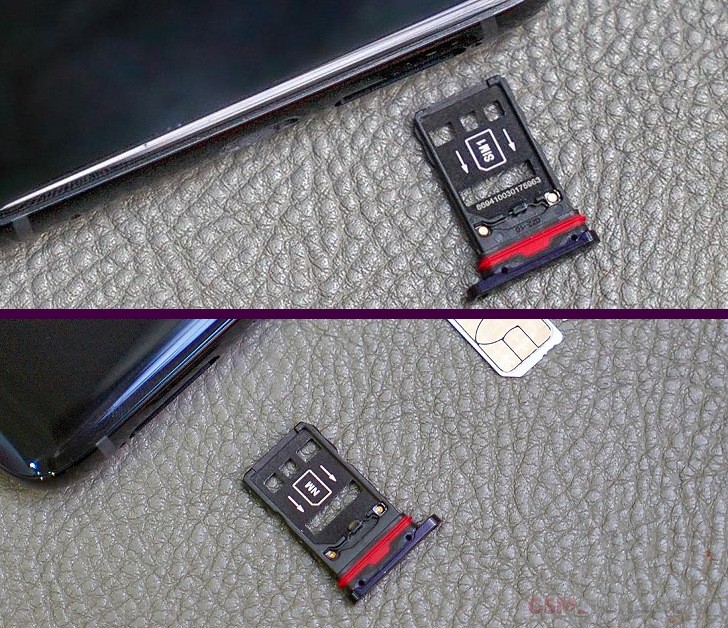
Huawei Mate 20 has a large 4,000 mAh battery, but it can do neither 40W wired nor any wireless charging. The Mate 20 does come with support for Huawei's 22.5W SuperCharge, which should be more than enough anyway.
Huawei Mate 20 spreads at 158.2 x 77.2 x 8.3 mm - that's as tall as the Mate 20 Pro but 5mm wider. The Mate 20 is also 8mm taller than the Mate 10, but equally wide and thick. Finally, all three of these Mates weigh the same at about 188g.
The Mate 20 is as slippery as it looks, which is worrisome for such a big device. Sure, the thicker frame and the grippy 'Hyperoptical' surface finish on the Midnight Blue option do add some grip, but nothing as major as you can imagine. And while the regular Mate 20 feels more secure in hand than the Pro, the extra silicone case, if available, would help a lot.
Display
The Huawei Mate 20 features a 6.53" IPS LCD, larger and taller than the 5.9" unit on the Mate 10, but the resolution is now 1080p - lower than both the Mate 10 and Mate 20 Pro. The actual pixel count is 2,244 x 1,080 meaning an 18.7:9 aspect ratio and 381 ppi density. There is a tiny waterdrop notch at the top for the selfie camera, while a sheet of Gorilla Glass protects the whole thing.

The screen has the same RGBW underlying matrix as the Mate 10 and should deliver superb brightness. It's HDR10-certified, too, and supports the larger DCI-P3 color space.

The RGBW subpixel arrangement replaces every second blue pixel with a white one - or rather every second blue filter is removed to let more light through. Which means instead of having a string of red-green-blue-white subpixels (RGBW), here you get a string, which looks something like GBR-GWR.
The screen of the Mate 20 has two Color modes - Normal and Vivid. Each of those also has three sub-modes - Default, Warm, and Cold.
The Vivid option corresponds to the DCI-P3 color space, while the Normal one switches to sRGB. Huawei hasn't specified this anywhere, so we had to find it by testing the screen in our lab.
Anyway, the Mate 20 comes set on Vivid by default and we suggest leaving it this way. The mode offers 491 nits of (manual) maximum brightness, but it can go as high as 780 nits in bright light if you leave it on auto. No matter the mode, the contrast is always excellent at north of 1400:1.
We also measured a minimum brightness of just 1.4 nits.
| Display test | 100% brightness | ||
| Black, cd/m2 | White, cd/m2 | ||
| 0.347 | 491 | 1415 | |
| 0.554 | 778 | 1404 | |
| 0.3 | 415 | 1383 | |
| 0.456 | 630 | 1382 | |
| 0.468 | 667 | 1425 | |
| 0.002 | 508 | 254000 | |
| 0.003 | 657 | 219000 | |
| 0 | 422 | ∞ | |
| 0 | 623 | ∞ | |
| 0 | 660 | ∞ | |
| 0 | 653 | ∞ | |
| 0 | 367 | ∞ | |
| 0 | 658 | ∞ | |
| 0 | 426 | ∞ | |
| 0 | 420 | ∞ | |
| 0.2 | 366 | 1830 | |
| 0.214 | 389 | 1818 | |
| 0 | 453 | ∞ | |
| 0 | 455 | ∞ | |
| 0.401 | 380 | 948 | |
| 0.403 | 426 | 1057 | |
| 0.225 | 460 | 2044 | |
| 0.499 | 920 | 1844 | |
| 0.314 | 461 | 1468 | |
| 0 | 458 | ∞ | |
| 0.002 | 624 | 312000 | |
The average deltaE we measured for the screen on Vivid is 3.4 with a maximum deviation of 8.5 - a fine enough. The color accuracy for the Normal (sRGB) mode is also fine with an average deltaE of 3.
The sunlight contrast on the Huawei Mate 20 is good, though washed out colors are expected under bright sunlight. You do get much better results if you use the auto mode that allows the phone to push the brightness much higher though.
Sunlight contrast ratio
Battery life
Huawei Mate 20, just like the Mate 10, is powered by a large 4,000 mAh battery sticking to a tradition dating back to the Mate 7 in 2014.
The Mate 20 supports the company's proprietary SuperCharge at 5V and 4.5A. The required cable and charger are bundled with the Mate 20 and they can fill 55% of a depleted battery in half an hour and reach 100% in an hour and a half.
There is no wireless charging support on the Mate 20. That, and the 40W Super Charge support, are reserved for the Mate 20 Pro.
In our testing, the Mate 20 lasted upwards of 14 hours looping videos and twenty hours running our web browsing script. The 3G voice call test returned a 23h talk time. All these standalone tests returned impressive scores, indeed.
The overall Endurance rating ended up 92 hours. Just as on the Mate 20 Pro, that's a bit lower than what we expected after such an excellent job on the screen-on tests, but the standby performance is just average, and it took its toll.

Our endurance rating denotes how long a single battery charge will last you if you use the Huawei Mate 20 for an hour each of telephony, web browsing, and video playback daily. We've established this usage pattern so our battery results are comparable across devices in the most common day-to-day tasks. The battery testing procedure is described in detail in case you're interested in the nitty-gritties. You can also check out our complete battery test table, where you can see how all of the smartphones we've tested will compare under your own typical use.
Speakers
Huawei failed to mention this, but the Mate 20 enjoys the same stereo speakers as the Mate 20 Pro, P20 Pro and Mate 10 Pro, among other devices. But unlike the Mate 20 Pro, the Mate 20 has its bottom speaker outside of the USB-C port.
Sadly, the Mate 20 still uses the tiny and squeaky earpiece for a second speaker, and it still sounds rather poorly. Yes, it does the stereo effect, but the loudness of the speakers is mostly uneven, and you can tell. At some point, it might even become annoying.
The Huawei Mate 20 speakers scored a Very Good mark in our loudness test, a decibel shy of Excellent. The sound quality is about average though, far from the best in the industry. While playing some music, the audio was loud enough, but it's rather shallow and often squeaky.
| Speakerphone test | Voice, dB | Ringing | Overall score | |
| 67.8 | 70.0 | 84.2 | Very Good | |
| 68.4 | 74.0 | 80.1 | Very Good | |
| 68.1 | 72.3 | 82.2 | Very Good | |
| 67.8 | 71.0 | 84.5 | Very Good | |
| 67.2 | 72.5 | 84.5 | Very Good | |
| 71.5 | 75.7 | 78.9 | Very Good | |
| 71.2 | 74.9 | 80.2 | Very Good | |
| 74.3 | 70.2 | 82.6 | Very Good | |
| 68.0 | 75.3 | 84.0 | Very Good | |
| 70.3 | 73.4 | 83.8 | Very Good | |
| 70.1 | 73.8 | 84.2 | Excellent | |
| 70.5 | 74.0 | 84.7 | Excellent | |
| 71.0 | 75.4 | 82.9 | Excellent | |
| 70.5 | 74.1 | 85.2 | Excellent | |
| 71.8 | 69.2 | 91.0 | Excellent | |
| 72.8 | 74.7 | 86.6 | Excellent | |
| 69.3 | 75.0 | 90.5 | Excellent | |
| 78.3 | 76.4 | 82.3 | Excellent | |
| 76.0 | 73.6 | 88.5 | Excellent | |
| 90.6 | 73.7 | 84.0 | Excellent |
Audio quality
The Huawei Mate 20 delivered decently accurate audio output in both parts of our test. All its scores were excellent with an active external amplifier and the damage dealt by headphones was minimal too.
Unfortunately, volume was only average so if you have very high-impedance headphones you may find the Mate 20 somewhat lacking. If that's not the case though, you should be happy with its performance.
| Test | Frequency response | Noise level | Dynamic range | THD | IMD + Noise | Stereo crosstalk |
| +0.02, -0.09 | -87.7 | 87.0 | 0.0024 | 0.012 | -87.8 | |
| +0.15, -0.07 | -92.1 | 92.0 | 0.0029 | 0.149 | -82.2 | |
| +0.02, -0.16 | -92.1 | 92.0 | 0.0017 | 0.013 | -85.6 | |
| +0.07, -0.07 | -92.1 | 92.4 | 0.0021 | 0.106 | -66.5 | |
| +0.03, -0.05 | -93.4 | 93.3 | 0.0010 | 0.0070 | -93.8 | |
| +0.17, -0.15 | -93.2 | 93.1 | 0.0056 | 0.245 | -61.1 | |
| +0.01, -0.02 | -91.2 | 93.2 | 0.0024 | 0.0080 | -88.7 | |
| +0.38, -0.21 | -93.1 | 92.5 | 0.0049 | 0.233 | -61.7 | |
| +0.01, -0.03 | -93.7 | 93.7 | 0.0017 | 0.0074 | -94.1 | |
| +0.03, -0.02 | -93.6 | 93.5 | 0.0033 | 0.046 | -93.2 | |
| +0.02, -0.15 | -94.3 | 94.3 | 0.0021 | 0.0069 | -94.3 | |
| +0.18, -0.13 | -93.7 | 93.6 | 0.0024 | 0.104 | -52.7 |

Huawei Mate 20 frequency response
You can learn more about the tested parameters and the whole testing process here.
Android Pie and EMUI 9
The Huawei Mate 20 runs Android 9 Pie under its thoroughly custom EMUI launcher, v9.0 in this instance. The Android purists are guaranteed not to like this combo, but Huawei has been working on its custom skins for years and nobody should have expected vanilla Android anyway.
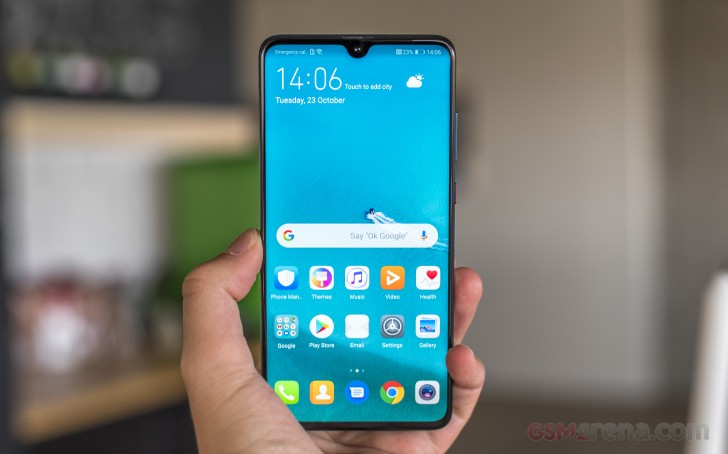
Huawei has cleaned up the general interface and the settings panel has been simplified by hiding rarely used settings under "advanced" sub-menus in more categories. Huawei's built-in apps are getting updated navigation menus along the bottom of the screen to make them easier to reach.
EMUI 9.0 also brings GPU Turbo 2.0, works for quicker app starts, and there is a new Password vault.
You get a better Huawei Share too, which can share files with a PC and print documents wirelessly.
A travel assistant by HiVision and in-house developed Digital balance app that tell you how much time you are spending on your phone and give you the option to limit yourself (the screen will go monochrome after the time is up) are in the package.
But in spite of all the novelties and newer Android version, the EMUI looks familiar so upgraders should feel right at home.
The Mate 20 doesn't have the fancy under-display fingerprint reader, nor it employs 3D face scanning tech. Being a cheaper device, the Mate 20 enjoys a regular fingerprint sensor on its back, always-on and very fast and accurate as usual.
Face Unlock is available, but it's just uses the front camera, which means it's less secure and can potentially be fooled by a picture. So, if privacy is of utmost importance, you may want to avoid this option.
You can either embrace the notch, or you can opt to mask it with a black status bar that extends all the way down to the bottom edge of the notch. The Mate 20 has one of the smallest notches around, so we'd imagine few people would choose to hide it.
Huawei has pretty also implemented its version of iPhone's gesture navigation - swipe up for Home, swipe up and stop midway for Task switcher, or swipe from the left or right edge of the screen for Back. Well, the iPhone does Back only from the left edge, so that's an upgrade, right?
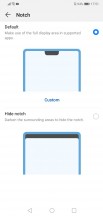





Notch control • Without the notch • Gesture navigation
Out of the box, there is no app drawer on the EMUI 9 - it's a single tier interface akin to iOS. However, if you prefer Android's usual two-tier layout, you can enable it from the Display settings.






Lockscreen • Covers • Homescreen • Homescreen styles • Digital Balance • Digital Balance
EMUI has Magazine lock screen, as usual, which cycles through a bunch of wallpapers (covers), so you see a different one every time you fire up the display.
Huawei's EMUI offers plenty of customization and features, smart rotation, and lift to wake. Themes are supported, too, and there is a lot to choose from.





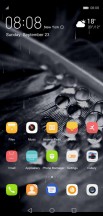
Fingerprint • fingerprint enrolment • Face recognition • Themes
The notification shade is a standard affair, with the usual Huawei take on the graphics. There's a brightness slider and a row of toggles, and you pull down again for more toggles.
Multitasking is a familiar affair too. Tap-holding the Recents key will let you activate the split screen mode. You could have a video playing on top of the two windows if for some reason you find that useful.


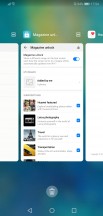
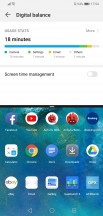

Notification area • Toggles • Recent apps • Split screen • Split screen
From the Phone Manager app, you can access shortcuts to storage cleanup, battery settings, blocked numbers, Virus scan powered by Avast, and mobile data usage.
Huawei's own Music app offers a way to listen to stored MP3s, while Huawei's Health app offers Google Fit syncing and step counting. There's a file manager app and a note-taking app. And if you don't like any of those - there is an abundance of alternatives in the Play Store.
There is an improved AI-powered gallery with EMUI 9. In addition to the automatic sorting with highlights, you will get an automatic but editable Spotlight Reel.
Unlike the Mate 20 Pro, the Huawei Mate 20 comes with FM radio support and there is an app to handle it. Nice!
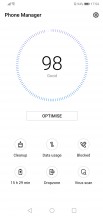


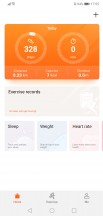

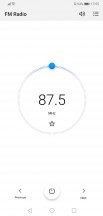
Phone Manager • Music Player • Gallery • Huawei Health • Files • FM radio
Huawei Mate 20 features an IR blaster on its top side. Thanks to its Smart Remote companion app, you can control all of your appliances with your Mate.

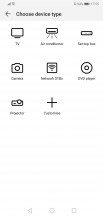
Huawei Smart Remote
The Mate 20 has a Kirin 980 chip
Huawei Mate 20, just like the rest of the Mate 20 family, utilizes HiSicon's latest Kirin 980 chip. This is the first chipset in an Android phone built on the 7nm manufacturing process and it's promising plenty of power and efficiency gains over its predecessor and other 10nm chipsets, including the Snapdragon 845.

The Kirin 980 uses an 8-core CPU design with 2x high-performance Cortex-A76 cores running at 2.6GHz and 2x Cortex-A76 cores clocked at 1.92GHz and 4x power-efficient Cortex-A55 cores that go up to 1.8GHz. The processor makes use of ARM's DynamIQ architecture, which is the evolution of big.LITTLE and allows any subset of cores (or all together) to work simultaneously depending on the workload.
Kirin 980 SoC has a Mali-G76 MP10 (ten-core) GPU, which should offer tremendous performance and efficiency gains compared to its predecessor Mali-G72 in the Kirin 970.
EMUI 9's GPU Turbo 2.0 is supported by six games in total for the time being. It allows all those games to run smoothly and steady at 60 fps at full resolution. GPU Turbo 2.0 is new, but Huawei is also working with game developers to enable it in even more popular games though we won't be holding our breath.
The 7nm manufacturing process isn't the Kirin 980's only claim to fame. The chipset is also the first to support 2133MHz LPDDR4X memory and incorporates a dedicated dual NPU chip. Huawei calls the latter "Dual-Brain Power" and can help recognize up to 4,500 images per minute, which is around 120% faster than last year's single NPU chip on the Kirin 970 SoC.
Finally, the chipset comes with a new Image Signal Processor, which delivers a 46% increase in data throughput and better multi-camera support. It promises an improved HDR color reproduction, Multi-pass noise reduction that removes artifacts without hurting with the image details and better motion tracking.
And now it's time to run some tests.
Benchmarks
Benchmarks scores have been driving the industry for quite some time. Many Chinese makers try to impress with higher and higher (AnTuTu) results, leading to tampering with the phone performance in order to look favorable in the eyes of the users.
At IFA 2018 in Berlin Huawei officials confirmed that the manufacturer is using benchmark detection software to deliver the best possible results, only because its competitors are doing it and it wouldn't want to be at a disadvantage.
Huawei then promised to make this hidden Performance mode available to anyone and now it's live in the new Mate 20 phones. You can find the switch in the Battery settings. Previous Huawei phones are getting this option soon, too.
Huawei claims this mode gives you the full unrestricted power of the Kirin chipset. Sure, it will drain the battery and the phone will get hot, but for whatever reasons you need every bit of speed - you can have it now. There is a catch, though.
Once enabled the performance mode does unlock the full potential, but all safety measures are still in place. And they better be, as the Mate gets hot fast, even before AnTuTu has finished its run, and then...it throttles. And when throttling occurs, you are no longer in full speed.
Long story short - the Mate 20 can offer a small speed boost at some occasions with its Performance Mode, but not for long. To get the optimal scores in this mode we had to put the Mate 20 in a fridge for the whole test run and after it was done the phone was not cold!
The results - well, about 10% boost across all benchmark tests for the first run. Yes, that's it. You can get a sustainable 5% boost from the regular mode over time, while the 10% bump is for the first few minutes only. So, we are not sure if the extra heat and battery drain are worth the hassle.
The Mate 20, performance mode or not, is on top of the whole Android pile, when it comes to multi-core processor performance. You can see the 10% gain from the performance mode quite clearly here.
GeekBench 4.1 (multi-core)
Higher is better
The single-core result of the Mate 20 CPU comes short of the Mongoose cores of the Galaxy Note9. The performance mode helps a little, but still not quite enough.
GeekBench 4.1 (single-core)
Higher is better
The Kirin 980 chipset has Mali-G76 10-core GPU in charge of graphics. The performance, while an improvement over the previous Kirin 970, wasn't impressive on the Mate 20 Pro because of the higher 1440p resolution. The Mate 20 on the other hand has a less needy 1080p display and should offer better, if not chart-topping performance.
In terms of sheer power, the Mate 20 is slightly slower than the Snapdragon 845's Adreno GPU. When we enabled the Performance mode though, and the Mate's GPU matches and sometimes even beats the latest Adreno in circulation.
GFX 3.1 Manhattan (onscreen)
Higher is better
GFX 3.1 Car scene (onscreen)
Higher is better
Basemark X
Higher is better
The compound benchmarks such as AnTuTu and BaseMark confirm the flagship nature of the new Kirin 980 chipset. If performance mode is enabled, both Mates score 10% higher and come on top of both charts beating the rest of the Android gang.
AnTuTu 7
Higher is better
Basemark OS 2.0
Higher is better
Huawei Mate 20 and its Kirin 980 are a worthy flagship pair. The chip offers the fastest processor on the Android market, as usual, while its GPU punch is close to that of the most current Adreno by Qualcomm.
The Kirin 980 is manufactured on the cutting-edge 7nm process, but if you expected it not to heat up - you'd be wrong. The chip does release a reasonable amount of heat and the Mate 20 Pro does have a few spots that get hot when you subject it to a lot of pressure. The phone won't go as hot as the previous Mates though. Some throttling may occur after running consecutive benchmark tests but only then.
The performance mode unlocks the full potential of the Kirin 980, which gave us a 10% boost in benchmark scores - and that is only when we kept the phone cold in the fridge. At room temperature the phone quickly heats up, throttles and you only gets about 5% benefit.
Huawei has delivered an all-around great chip with a class-leading processor and competitive graphics core. It has better thermal control and less throttling than the previous Kirin 970, too, making this arguably the first occasion when the Kirin chipset is actually an advantage for the Huawei rather than a shortcoming.
A different triple camera
Both Mate 20 phones pack triple-camera setups with dual-LED flash on their backs. Those four things are packed together into a square that should go down in history as the signature design feature of this Huawei Mate generation.
The setup waves goodbye to the monochrome and we won't miss it much. It was very helpful for boosting low-light performance before chipsets could do multi-frame image stacking for noise reduction, but now all it provides are slightly better artsy black and white shots and we can agree Huawei did the right thing by putting a wideangle camera instead. The setup is Leica-branded, coming with the exclusive color filters if those happen to be your thing.

Even though the Huawei Mate 20 packs a triple camera setup similar to the Mate 20 Pro (wide, regular, telephoto), none of the cameras used match. The Mate 20 has a primary 12MP 1/2.3" shooter with 27mm f/1.8 lens and an 8MP snapper with 54mm f/2.4 lens for telephoto purposes. The final camera is a 16MP one with ultra-wide angle 17mm f/2.2 lens. All of them lack optical stabilization.
As an added bonus to the ultra-wide-angle camera, Huawei says everyone will be able to shoot some impressive macro shots with it as the phone can focus from as close as 2.5cm.
Huawei Mate 20 offers only 2x optical zoom - there is no hybrid zoom nor 80mm 3x lens as was the case on the Pro. You will find 2x option in its camera app, while the wide-angle camera is called 0.6x.
The camera app is enhanced by Huawei's AI just as before. There is Master AI 2.0, which can now recognize and tune settings for up to 1,500 different scenes. Huawei has made it less aggressive on the trees and skies, after the negative feedback it received for the P20 Pro where the Greenery and Blue Sky modes were over the top. We are happy with the presets used on the Mate 20 but if you'd like to keep the Master AI turned off, the switch for that is in the Camera app's Settings page.


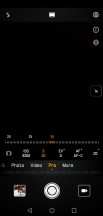


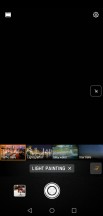
Photo • Aperture • Pro • All modes • Monochrome • Light Painting
The camera app itself hasn't changed much since the P20 series. First off, you have a mode selector on the bottom. You swipe left or right to change modes, but you can't swipe on the viewfinder, just on the selector itself. Swiping up and down doesn't switch between front and rear camera either, you have a button for that (admittedly, it's at the bottom within easy reach). Basically, you're still wasting the viewfinder by not having gestures enabled on it, except for pinch to zoom.
As for switching between cameras, a tap on the '1x' button in the viewfinder toggles consecutively the '2x' (54mm), and the '0.6x' (17mm) cameras.
There's a Pro mode here where you can adjust parameters yourself - ISO (50 to 3,200), shutter speed (1/4000s to 30s), exposure compensation (-4 to +4EV in 1/3 stop increments), and white balance (presets and specific temperature). You can also choose the metering mode (matrix, center-weighted and spot), and the focus mode (single, continuous and manual). If the phone thinks you messed up the exposure, an icon will pop up to warn you.

The monochrome mode is still available in spite of the Mate 20 not having a dedicated B&W camera. It's in the 'More' section, where the extra modes are: Monochrome, Panorama, and HDR, among others. And while we're at it, what's with the manual HDR mode when everyone else has some sort of Auto HDR already enabled?
Since bokeh effects became all the rage, Huawei phones have had both a Portrait mode, and an Aperture mode. There's now more differentiation than ever between the two. In Aperture you can choose the simulated aperture in the range from f/0.95 to f/16. Post shot, you can change the aperture and the focus point within the Gallery.
In Portrait mode you can enable and disable the background blur (why disable it if you've chosen the mode in the first place, though), but you can also choose the bokeh shapes - circles, hearts, swirl or discs - which can produce some really cool effects! You can also opt for simulated lighting, and you can even add some beautification on a scale from 0 to 10.



Portrait • Portrait Lighting • Portrait Blur
The Mate 20 records video up to 4K resolution at 30fps - there's still no 4K/60fps mode, though. You can, however, choose between h.264 and h.265.
There's super slow-mo recording as well, in what's become the industry-standard 720p/960fps, as well as 'regular' slow-mo in 720p/240 and 1080p/120fps. While the regular slow-mo clips are only limited in length by your free storage, the super slow-mo clips last precisely 10s - 6s of slow-mo and two seconds of regular speed action on both ends.
Huawei is offering the so-called HiVision smart assistant as part of the camera app. It's basically an alternative to Smart Lens, automatically recognizing landmarks, art, and food. Some of the smart functions include text translation and calories count.
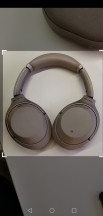




Huawei HiVision
Image quality
While the 0.6x mode isn't the default one when you start the camera, we figured it's the right place to start with the examining of the Mate 20's image quality.
There is plenty of resolved detail in the photos we took with the ultra-wide-angle camera. The color rendition is excellent, true to life, the noise levels are very low, and the dynamic range is often superb, probably due to the multi-stacking magic.
There is corner softness, but it is much less evident than on what we observed on the Mate 20 Pro pictures. The chromatic aberrations, which are expected with such a wide lens, are also rarer on the Mate 20 images than on the Pro's.








Huawei Mate 20 16MP ultra-wide-angle samples
The ultra-wide-angle cam can also do for macro shots. These are quite good in quality and will do for the occasional shooting of flower petals, bugs, and other tiny peculiar things. Yes, chromatic aberration is noticeable here and there, but it's not too bad.




Huawei Mate 20 16MP macro samples from the ultra-wide-angle camera
Moving on to the regular photos. Those come from the 12MP sensor with the bright f/1.8 lens. There is one easy rule with the Mate 20 - if the ultra-wide-angle camera didn't take it, then it's a 12MP photo. That's right; even the 8MP telephoto camera spits out 12MP images.
Anyway, the regular camera photos in good light are great. There is plenty of detail, impressive dynamic range, lively and accurate colors, superb contrast, and, overall, very mature processing rendition. The foliage presentation sometimes has the painfully familiar oil-painting look, but we guess this is the price to pay for the frame stacking. It's not always that bad, not at all, but some of the greenery could have looked better.
So, the 12MP regular viewing angle photos are great looking and we are confident most users will be happy with them.










Huawei Mate 20 12MP regular samples
The 54mm tele camera is only 8MP, but the photos we get out it are 12MP, so we suspect the 12MP one lends a hand through some image stacking because when there's enough light the per-pixel detail is close to what the main camera produces. The upscaling artifacts are there, but they are really hard to spot. The color, contrast, and dynamic range are good, although the noise levels are a bit higher.










Huawei Mate 20 12MP telephoto samples
Remember the overly aggressive Master AI on the Huawei P20? Good news, folks, version 2.0 has been reworked, and we no longer get over-the-top Greenery and Blue Skies photos. If the phone recognizes a Blue Sky or Greenery scene, the algorithm applies only a minor contrast boost and very slight extra saturation of the blues or greens. But nothing over the top as on the P20.




Master AI • Regular • Master AI • Regular
Now, it's time to move to those low-light scenes. For the sake of consistency, we started from the wide-angle camera once more.
The 16MP camera has f/2.2 aperture and isn't optically stabilized. The image quality turned out abysmal - the resolved detail is very low, the noise levels are extremely high, and you can barely see what's on them. Unlike the Mate 20 Pro, the Mate 20 ultra-wide-angle camera isn't fitted for low-light shots.




Huawei Mate 20 16MP ultra-wide-angle low-light samples
Luckily, this is where the Night mode comes in. It will produce quite usable wide-angle pictures, even if it has its limitations. It creates pseudo long exposures by stacking multiple frames gathering light along the way. We're talking three-, sometimes five-second-long hand-held exposures which would otherwise result in a blurry mess. Those are not always keepers and you still need to have a reasonably steady hand, but you'll be getting usable photos in situations you'd otherwise get none. The phone also does a remarkable job of retaining color where others would lose saturation.




Huawei Mate 20 16MP ultra-wide-angle samples with Night Mode
The 12MP low-light photos we took with the main camera are very good. It has bright f/1.8 aperture and even though it lacks optical stabilization, the shutter speed won't go lower than 1/25s, so blurred images are highly unlikely.
And the pictures are great - plenty of detail, nice exposure, excellent contrast, and some very nice-looking colors. If Master AI is enabled, it will rarely use the Night Mode when using the regular camera. The noise is well managed, although the Mate 20 Pro still has an edge there.




Huawei Mate 20 12MP regular low-light samples
The Night Mode produces brighter images and pops more detail in both shadows and highlights. Moving subject will get blurred, but other than that - those turned out to be some impressive photos.




Huawei Mate 20 12MP regular samples with Night Mode
Finally, Huawei Mate 20 won't use its telephoto camera at night, just like many other flagships do. Instead, it will crop and digitally zoom from the regular 12MP camera and the quality is, understandably, very poor.




Huawei Mate 20 12MP telephoto low-light samples
We also experienced this stunning sunset, while working on the review so we decided to take a shot with each camera. Enjoy!



Ultra-wide-angle • Regular • Telephoto
And here you can see how the Mate 20 cameras compare against other snappers in our extensive pixel-peeking database.



Huawei Mate 20 (12MP) vs. Mate 20 Pro (10MP) vs. Pixel 3 (12MP) in our Photo compare tool



Huawei Mate 20 Ultra Wide (16MP) vs. Mate 20 Pro Ultra Wide (20MP) vs. Mate 20 Telephoto (12MP)
Shootout - Mate 20 vs. Mate 20 Pro
Huawei Mate 20 has a different triple camera on the back, which on paper seems less capable than the Mate 20 Pro's. And we are sure many of you are wondering what will be the difference in quality. So, we took both phones for a spin, shot some pictures, and here's how they stack up. We've left the telephoto cameras out of this as the difference in the field of view (52mm vs 80mm) makes it very hard to compare those fairly.
In well lit environments the Huawei Mate 20 and Mate 20 Pro photos are pretty much identical in quality. The field of view, the color rendition, the contrast, and the dynamic range - those are all on par. In fact, we observed more resolved detail in areas of uniform color and texture on the 12MP Huawei Mate 20 shots. The Mate 20 foliage presentation was a little bit better as well, with better defined grass and leaves.
So, it turns out that if you are into pixel-peeping, the Huawei Mate 20 might actually be the better shooter for the sunny scenes.
You can use the shortcut for our side-by-side photo compare tool available on each section of samples.








Huawei Mate 20 12MP daylight photos








Huawei Mate 20 Pro 10MP daylight photos
The 16MP ultra-wide angle shots are also close to what that Mate 20 Pro can do with its 20MP ultra-wide angle camera. The regular Mate 20 enjoys less noise and corner softness, and slightly better foliage presentation, but the Pro resolves more detail elsewhere. The latter of course is to be expected as the Mate 20 Pro shoots in higher resolution.
Still, for most intents and purposes, the ultra-wide-angle shots in bright days are equal.








Huawei Mate 20 16MP daylight ultra-wide-angle photos








Huawei Mate 20 Pro 20MP ultra-wide-angle daylight photos
The regular 12MP camera on the Mate 20 shoots good low-light photos, while the Mate 20 Pro captures excellent ones. The 10MP Pro photos have less noise, more detail, better exposure and dynamic range. The Mate 20 Pro clearly demonstrates its higher standing when the conditions get tough.




Huawei Mate 20 12MP low-light photos




Huawei Mate 20 Pro 10MP low-light photos
The ultra-wide-angle comparison results in similar conclusions. The photos we took with the regular Mate 20 are noisier than the Pro's, have less detail and poorer contrast, and the colors are washed out. Their dynamic range is quite poor, too. The Mate 20 Pro wins this round, too, even if its images are not that impressive, either.




Huawei Mate 20 16MP ultra-wide-angle low-light photos




Huawei Mate 20 Pro 20MP ultra-wide-angle low-light photos
The main camera on both Mate 20 and Mate 20 Pro capture some brilliant low-light photos with the Night Mode. The Mate 20 Pro images are superior though, with no detail falloff towards the corners, more detail and less noise. The difference isn't that big though, so no matter which of these two devices you own, you will be quite happy with its Night mode.




Huawei Mate 20 12MP low-light photos with Night Mode




Huawei Mate 20 Pro 10MP low-light photos with Night Mode
The ultra-wide-angle cameras can do Night Mode, too. The Mate 20 images are a bit noisier than the Mate 20 Pro's, but other than that - on par as far as detail, colors, and contrast are concerned.




Huawei Mate 20 16MP ultra-wide-angle low-light photos with Night Mode




Huawei Mate 20 Pro 20MP ultra-wide-angle low-light photos with Night Mode
So, the Mate 20 seems just as capable as the Pro in daylight (even slightly ahead), while the Mate 20 Pro excels the low-light scenarios.
Portraits
Huawei Mate 20 has three cameras on its back and would have been inexcusable if Portrait Mode wasn't present. The feature, however, has changed since the P20 series.
For starters, you can't choose the blur strength as you could before. Instead, you can use one of the few bokeh highlights shapes - circles, hearts, swirl or discs.








Huawei Mate 20 12MP Portraits with different bokeh effects
The subject separation is very good - in fact it's among the best we've seen in a while. The different effects are also a departure from what we're used to seeing, and we found them cool and a breath of fresh air.




Huawei Mate 20 12MP Telephoto Portraits with different bokeh effects
Then there are Portrait Lighting effects, which have tolerable-but-not-great subject separation and generally aren't our cup of tea.




Huawei Mate 20 12MP Portraits with different Lightning effects
Finally, in addition to those blur and/or lighting effects, you can also use various skin and face beautifications, but we didn't dig deep there.
Aperture mode
The Mate 20 also features the so-called Aperture Mode. It lets you do post-shot re-focusing and simulates apertures in the f/0.95-f/16 range. It can be used for both human and non-human subjects and does well with the subject isolation even with more complex shapes.




F/1 • F/2.4 • F/4 • F/6.3




F/1 • F/2.8 • F/3.5 • F/5.6
Selfies
The Mate 20 feature a 24MP f/2.0 camera with fixed focus for selfies at the front, borrowed from the P20 series. It can do portraits with various effects as usual. Its performance isn't nearly as spectacular as the high pixel count might suggest, though.
We'd trade half of those megapixels for autofocus any time, or at least for a focus sweet spot that's further from the phone, because as things stand right now, you need to shoot your face from pretty close for it to be in sharp focus. If you do manage to stay within the camera's fixed focus sweet spot, the level of detail is quite amazing. Colors are faithfully represented, and dynamic range is good for a selfie camera.






Huawei Mate 20 24MP selfies
There is AI HDR turned on by default for the selfies and we strongly recommend leaving it on. It does a splendid job in recovering detail in the highlights.


AI HDR • no HDR
The front camera has the same Portrait mode as the main one, but the subject separation is far inferior. You can see ears and hair have gone missing on some of the shots. The cool blur effects have made it to the selfie portrait mode, too, which is nice.




Huawei Mate 20 24MP Selfie Portraits with different bokeh effects
And you can, of course, use Portrait Lighting effects, if those are your thing, but with the poor subject separation they have very limited applications.




Huawei Mate 20 24MP Selfie Portraits with different Lightning effects
Video recording
The Huawei Mate 20 isn't introducing any new shooting modes over the P20 series, which means still no 4K at 60fps. You have a choice between the h.264 and h.265 codecs.
There is an always-on electronic stabilization available in every mode but the 1080p/60fps one.
You can shoot video with each camera in any resolution and use the 0.6x, 1x, and 2x triggers as you prefer. Oddly, we found out that in 1080p at 60fps the 2x footage is not from the 2x camera, but is digitally zoomed from the normal one.
The 4K footage of either camera is average - it lacks sharpness big time. The resolved detail isn't terrible, but we've still seen mid-rangers do better. The colors sometimes are washed out, but the contrast and the dynamic range are pretty decent.
The always-on electronic stabilization might be responsible for this softness, but we can't be sure as there is no way to disable it.
Disappointingly, the 4K videos we shot with the wide-angle camera have a frame rate of only 22-24fps instead of the regular 30fps.
The closeup videos are quite good, though. The Mate 20 has spectacular EIS and even videos shot at night look great. The recorded audio is stereo with 192kbps bitrate and thanks to the high bitrate you will get excellent quality even at a concert. The video below is from the Mate 20 Pro, but it is representative of what you'd get with the Mate 20, too.
The 1080p footage looks sharper and these are among the best 1080p videos we've seen. The resolved detail is great, as are the colors, contrast, and the dynamic range.
The 1080p videos at 60fps are less detailed than the 30fps ones, but are otherwise a close match to the 30fps ones.
As usual, we've provided samples straight out of the camera for you to download - 2160p@30fps normal(10s, 36MB), 2160p@30fps 2x zoom (10s, 35MB), 2160p@30fps ultra-wide (11s, 25MB), 1080p@30fps normal (10s, 15MB), 1080p@30fps 2x zoom (10s, 15MB), 1080p@30fps ultra-wide (10s, 14MB), 1080p@60fps normal (10s, 23MB), 1080p@60fps 2x zoom (10s, 24MB), and 1080p@60fps ultra-wide (11s, 23MB).
Finally, you can use our Video Compare Tool to see how the Huawei Mate 20 cameras stack against others when it comes to video capture.



2160p: Huawei Mate 20 against the Mate 20 Pro the Pixel 3 in our Video compare tool



2160p: Huawei Mate 20 Ultra Wide against the Mate 20 Pro Ultra Wide and Mate 20 Regular
Final Thoughts
Huawei Mate 20 is intended mostly for markets where the Pro model isn't available, much like the Mate 10 was last year. And the Mate 20 is shaping to be one very reasonable refresh over its predecessor.
It brings a larger LCD screen with richer color support, a much faster Kirin chipset, and a massive camera upgrade on the back. The new triple cam at the back is far more versatile than the old dual-setup as it can go both wider and longer.

The Mate 20 isn't quite as great as the Mate 20 Pro, but it wasn't meant to be. It gets to keep the essentials - the new design, big screen, powerful chipset, and large battery, while cutting a few corners with the LCD panel and the inferior tri-camera to keep the price lower.
And it worked! The Huawei Mate 20 may have different sensors behind that signature square at the back, but it still matches the Pro's photo and video quality on plenty of occasions. Admittedly, the Pro easily comes out on top at night, but we wouldn't say the difference is as big as the gap in pricing.
While some might prefer the Pro's AMOLED panel, this flat LCD has a lot going for it too. The waterdrop cutout is easier on the eyes, it's bigger and the lack of curves makes it easier to apply screen protectors.
Also, while the Mate 20 misses on the super fast 40W charging on the Pro, we never thought that its 22.5W Super Charge is slow or inadequate.
So, the Huawei Mate 20 is doing a great job of delivering the flagship experience, while undercutting the Pro price significantly. It is an exercise in stripping away gimmicks and not paying over the odds to improve on what is already working very well.
The Competition
The last couple of months have seen a dozen of flagships go official and it will be one very tough shopping season. The Mate 20 will be facing some major threats out there and they deserve to be explored.

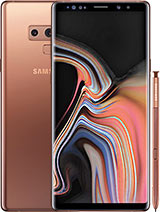
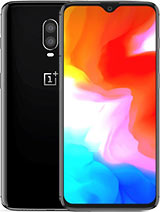


Samsung Galaxy S9+ • Samsung Galaxy Note9 • OnePlus 6T • LG V40 ThinQ • Huawei P20 Pro
Samsung has two great smartphones on the market right now. The Galaxy S9+ is already cheaper and has the curvy AMOLED screen plus an interesting camera with variable aperture. The custom Exynos chipset is as fast as the latest Kirin, but in the end the Mate 20 camera is the better all-rounder and EMUI 9 is based on Pie, whereas TouchWiz is still waiting for an update.
The Note9 is a bit more expensive than the Mate 20, and in addition to all the cool S9+ features, it adds a larger screen, battery, and, of course, the S-Pen. If the ultimate phablet experience is a must, the Note9 might be the better fit for you.
The OnePlus 6T is as fresh as the Mate, with similarly notched screen, but an OLED at that. The Snapdragon 845 is still the fastest silicone Qualcomm has to offer, too. OnePlus introduced its own Night Mode and the 6T does it faster than Huawei, but the photos aren't on par in quality. Still, the 6T is quite cheaper, so there is that.
Finally, the water-tight LG V40 ThinQ will be putting some pressure on the Mate 20. It has an OLED screen of a similar size but of a higher resolution. The V40 is equally fast and has a triple camera of the same logic - ultra-wide, wide, and telephoto. The snappers have optical stabilization though, and the V40 can do 4K@60fps, too. The V40 is yet to broaden its market availability, but it's getting there.
And finally, if you like Huawei's take on everything, but can't live without an AMOLED or/and the 3x and 5x zoom in the camera, then there is the Huawei P20 Pro. It can't do ultra-wide-angle shots, but it has the better screen and larger camera zoom at a cheaper price.

The Verdict
Huawei Mate 20, where available, is an easy smartphone to recommend. It has a great large screen with a tiny notch, a top of the line chipset for flagship-grade performance, and a camera that is among the best you can get in a smartphone today with a ton of shooting modes.
The Mate 20 lacks waterproofing, but is among the few remaining flagships with a 3.5mm jack and FM radio support. And while the triple camera isn't as impressive as the Pro, it turned out to be a very capable performer.
The Huawei Mate 20 isn't a crippled Mate 20 Pro. It's one powerful smartphone, with thoughtfully picked features, and it's more than capable to stand its ground. We can see many people deciding on saving €300 and opting for the less fancier but equally capable Mate 20, if they get that kind of choice at all, of course.
Pros
- Nice design with flat front and grippy glass back
- Bright display with great contrast, small notch
- Dependable battery with SuperCharge support
- Top of the line Kirin 980 chipset with AI
- All-round camera experience with great daylight and night shots
- Excellent video stabilization
Cons
- No water resistance
- Low-quality top speaker
- NM cards only!
- No autofocus on the selfie camera
- Abysmal low-light performance of the ultra-wide-angle camera
- The 4K video quality could have been better

0 Comments